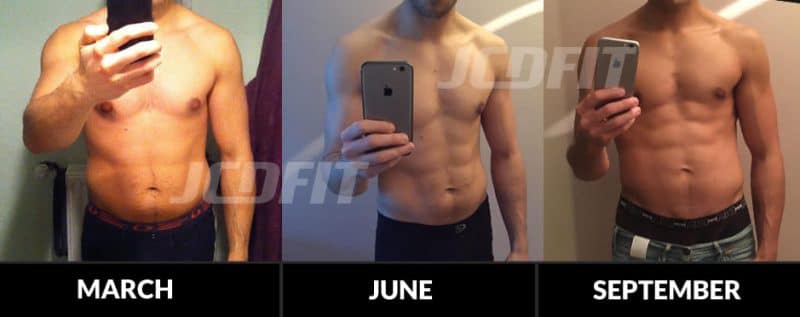If you want to lose fat, you have to do the following, without question:
- Eat fewer calories than you burn (put yourself into a caloric deficit)
- Exercise regularly (weight training is ideal, but any exercise helps)
- Give it a solid effort over time (months, not a few days here and there)
Fat loss is may seem like a complicated process, but it doesn’t have to be. The truth is this; most fat loss advice on the internet sucks. Much of it is wrong and impractical.
In this article, I’m going to carefully break down the entire process and make fat loss as simple and easy to understand as possible.
After reading this guide, you’ll walk away knowing the following:
- What fat loss is (and what it isn’t)
- How fat loss happens and how it works
- Why you are programmed for failure (and how to get beyond this faulty programming)
- The key lessons that will ensure you lose fat and keep it off for the long-term
- How to lose fat effectively without spending hours upon hours of exercising and without trying to survive on nothing but veggies and chicken breast forever
Table Of Contents:
- What fat loss is (and isn’t)
- How fat loss occurs (how it works)
- Understanding your energy expenditure
- Make it easy with my fat loss macro calculator
- Fat Loss Failures
- Keystone Fat Loss Behaviors
- How to lose fat and keep it off
- The Lose Fat Workout Plan
- The Lose Fat Diet Plan
- The Most Important Fat Loss Macro
- Fat Loss Supplements
- Fast Fat Loss
- How To Get Results
Fat Loss: What It Is And What It’s Not
To be very clear here, so-called weight loss is not fat loss.
When you lose weight, you’re noticing a change in the scale weight. One day you might weigh 200 pounds and the next day you might weigh 198 pounds.
But that two pounds you lost is most likely not going to be actual fat loss.
Weight loss is a simple reduction in body weight. Nothing more.
You can go to the bathroom right now and depending on much you urinate or defecate, you’ll lose 1-2 pounds easily. Yes. Go take a giant poop and you’ll lose weight fast.
If you want my full-on guide to pooping for weight loss, get on my waitlist. Jokes, people.
It’s a JOKE.
Anyway… Instead of just pooping, you could take a diuretic (not recommended) and lose a lot of weight via water loss.
This is why losing weight is not the same as losing fat.
Simple manipulations in your fluid intake can yield upwards of 20-pound swings for men and up to 10-pound fluctuations for women in body weight, without actually losing any body fat.
If you don’t believe me, spend a week restricting your carbohydrate intake to 50 grams or less per day while overeating fat calories to keep you at your caloric maintenance, which will make you lose a lot of water.
Then go to a Chinese buffet and pig out over the weekend. You’re guaranteed to gain at least 10 pounds overnight due to the carbohydrates being stored as glycogen and all the salt in the food making you retain water.
This is where the ever-popular, quick-fix juice cleanses and fasting protocols come into play.
Want to drop 10 pounds by the weekend?
Great, try this water, lime, honey, and cayenne pepper cleanse for the next 3 days. You’ll lose a lot of water by restricting your carbs and calories.
And you’ll easily fit into those tight pants for the party.
But beware, the water retention will come back, and those pants won’t fit as nicely as they did a few days ago.
It’s called a quick-fix for a reason, and it’s far from what we’re truly after, right?
Weight loss is not the same as fat loss.
No one truly wants to just lose weight. That’s easy. We want the weight loss to be in the form of fat, and ideally to keep it off with good habits, plus a solid diet and exercise plan.
Here’s What Fat Loss Is
Fat loss is the reduction in fat mass from your body. When someone has a drastic transformation from fat to ripped, it’s because they lost a lot of fat, not muscle.
This is what you want when you’re trying to lose fat.
Let’s get into how fat loss happens.
What Causes Fat Loss (The Caloric Deficit)?
A consistent negative (-) energy balance, over time, is what makes you lose body fat.
Energy in (eating food), energy out (expenditure), and your unique maintenance-level intake are all factors in what actually makes you lose fat.
To put it simply, all you need to lose weight is a calorie deficit. Notice the word ‘weight’ here.
This means by the end of the day (or week, or month on a longer timeline), you’re in a negative energy balance by creating a caloric deficit, which simply means you’re burning more food energy than you’re ingesting.
Simple math: If you burn 2800 calories in a 24-hour period, and only consume 2300 calories, you’re in a 500 calorie deficit. So, that energy is going to come from somewhere. If you create the caloric deficit properly, your body will use its reserves (either stored glycogen or body fat).
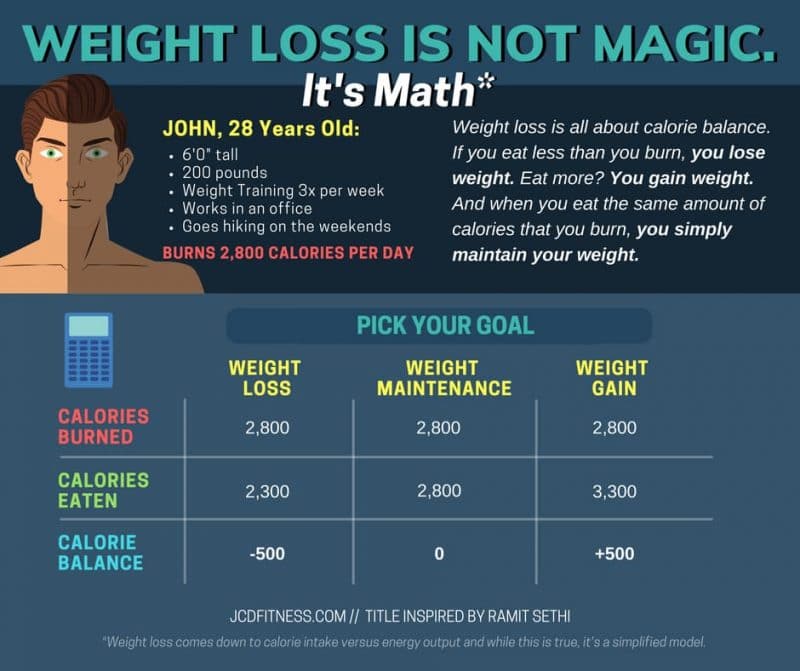
How your body determines where to obtain the energy from is a very complex process.
You have three forms of energy it can pull from. Those are protein (the protein you eat or in the form of lean body mass, a.k.a. muscle), fat (the stuff on your tummy and butt) or stored carbohydrates (glycogen) in the muscles/liver.
In short, your body uses the food you eat in the form of carbs, protein, and fat, which are also known as macronutrients.
Of course, through diet, and training, we want to influence the body to burn mostly fat when we go on a calorie-restricted diet, but this is not in our control 100% of the time.
Your body thrives on sugar metabolism (aka burning glucose, which is the simplest form broken down in the blood). It’s our preferred energy source during intense exercise and our brains use glucose to function.
Then, mostly at rest (sitting, sleeping, etc.), we burn fat for fuel, which is arguably the second most readily available energy source.
One thing I want to make note of before we go further is this: us fitness experts have our preferred methods of making fat loss happen. But to be fully transparent, it’s a complicated biochemical process that involves various hormones in the body, the effects of food you eat, stress levels, and your personal energy expenditure.
While I continue to get results with my personal fat loss clients, you should know that what works for them or myself may not work perfectly for you. But by using this guide, you’ll learn everything you need to know to lose body fat and keep it off.
Defining The Deficit
For sake of this article, we’ll make the following definitions.
- Small Caloric Deficit: 200-300 calories below maintenance per day
- Moderate Caloric Deficit: 500-600 calories below maintenance per day
- Steep Caloric Deficit: 600+ calories below maintenance per day
The size of the dietary deficit will be determined by various factors, more of which we’ll cover later.
Dieting For Fat Loss
When you’re dieting to lose fat, your success comes down to a handful of principles.
Those are:
- Protein intake needs to be sufficient to prevent muscle loss. Read: how much protein do I need? In general, this is .8 – 1 gram per pound of body weight (or lean body mass if you’re over 30% body fat)
- Getting enough calories, in general, to make fat loss happen at a reasonable rate (around 1 pound lost per week) but not too quickly so that you lose muscle mass
- Hunger management
- Getting sufficient sleep (7-9 hours per night)
- Sufficient time away from the gym for recovery
- Having the discipline and consistency to make predictable progress over time
- Having a plan for your exercise, training, and nutrition that is realistic and practical for your schedule
Now that you’re aware of the principles that must be in place to lose fat, here’s some real-world proof of how it happens.
Here’s how my client Salim lost 15 pounds of fat without going low carb.
When Salim and I worked together, he wanted to improve his strength and work on some cardio goals (boxing). So I had to craft a plan that made sense that would ensure he had the energy for his workouts but was also able to lose fat consistently over time
And because I wanted him to make steady strength gains, I made it a point to give him enough carbohydrates on his diet. We also incorporated cheat days (as well as refeed days) to help him maintain his performance and sanity.
With him, it was all about managing the intake on a weekly basis to create a calorie deficit of roughly no more than 500 calories per day. On the weekend, we’d have a high-calorie carb refeed to refill his muscle glycogen and keep fat loss happening the further we got into the diet.
Salim was training very hard on this program, working out with weights 3 days per week, performing heavy compound movements. He was also boxing a few times per week for cardio improvements.
Exercise and Weight Training For Fat Loss
If you have the goal of losing purely fat and maintaining all your muscle mass, you will want to be doing some form of resistance training… In my experience, I’m highly partial to traditional strength and bodybuilding style training to maintain and even gain muscle on a fat loss diet.
Before I go further, we should make something very clear: while exercise burns calories, its primary purpose is to stimulate your muscles. As a result of using your muscles and performing intense workouts, you’re going to maintain or even gain muscle while losing body fat.
Many people go on a calorie restricted diet, forget exercise altogether, and end up losing weight. But instead of looking much leaner and more defined 20 pounds lighter, they look like a smaller version of their former fat selves.
This is what we might call the skinny-fat look—someone who looks thin in clothes but has a layer of fat on their body with hardly any muscle tone.
The difference between ending up as skinny-fat or lean and muscular all comes down to resistance training.
Here’s exactly how exercise factors into weight loss.
Exercise does two things specifically.
Those are:
- It burns calories, which increases your total caloric expenditure
- Weight training helps you maintain and/or gain muscle mass
With all of my clients and customers of my premium programs, weight training is the primary form of exercise. Cardio training always comes secondary, and sometimes it’s not even necessary.
In fact, I cover everything you need to know about doing cardio for weight loss. I also cover my favorite form of cardio: walking for weight loss.
For maximum fat loss and muscle maintenance, you want to prioritize weight training in your weekly schedule. And for sake of time, if you are limited in how much you can exercise, you’re going to be far better off for choosing weight training over cardio.
So if you only have 3-4 hours per week to dedicate to exercise, it’s ideal to make sure you’re following a smart, structured weight training program on those days as opposed to a random cardio session.
Weight training has a far better return on investment for the time you spend doing it.
For instance, take my client Stephanie. She lost 13 pounds in 8 months.
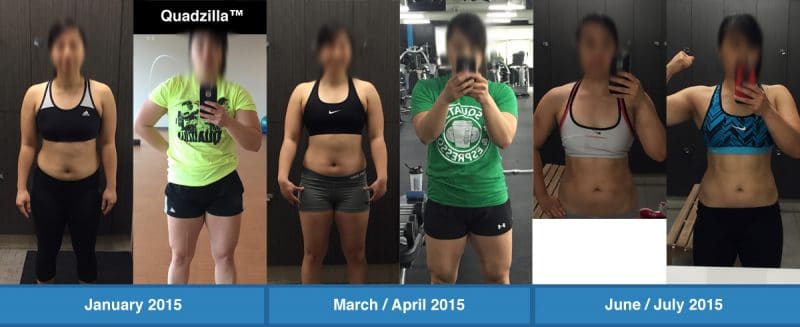
On the surface, her body composition changes are very evident. But if you look at the timeline of 8 months, 13 pounds doesn’t seem like much to lose.
First of all, she didn’t have a ton of weight to lose, and with the amount of weight training we did during this time, I know she gained muscle during the process.
I had her training hard 3 to 4 days per week and most of her activity came from casual walking during part of her time when she was living abroad in Taiwan and Japan.
For another example, take my client Chris:
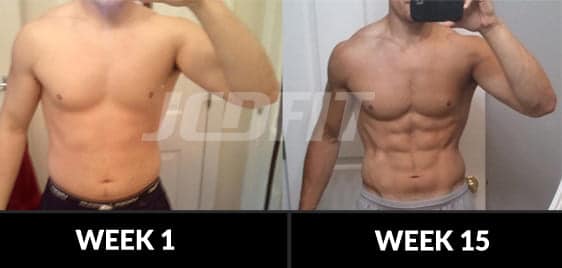
You can read more about how Chris got into his best shape ever.
Chris had a very busy schedule and was able to get in 3 weight training days per week. That’s it.
And since he prioritized weight training and focused on creating a caloric deficit, he was able to shed 15 pounds in 16 weeks.
The image above speaks for itself in terms of just how important weight training can be for maximizing your time spent exercising.
And the best part is… you don’t have to live in the gym to get your best results.
How Weight Training for Fat Loss Works
First of all, most all weight training workout plans will work for fat loss.
When you’re training and following a program while losing fat, the stimulus from the heavy weight training will help your body maintain muscle and utilize fat for fuel.
The main mistake people make when trying to lose fat is placing too much focus on cardio and not enough effort with their weight training.
And this causes them to lose more muscle than fat when dieting, so instead of looking leaner and more muscular, they end up looking like a skinner, less-fat version of their former self. This is the skinny-fat issue I mentioned above.
But you can’t just go to the gym and ‘lift weights’ sporadically.
You must have a plan and here are some basic guidelines to follow:
- In general, 3-5 training sessions per week is enough
- Each session should last no more than an hour from start to finish
- Your days off of training should maximize your ability to recover (hint: you should get plenty of rest)
- Strength maintenance should be a priority (meaning if you’re not maintaining or gaining strength from workout to workout, you’re probably doing too much)
- The plan has to be sustainable (more on this later)
A common misconception with training for fat loss is you should be doing light weight for many reps. And the opposite of that, heavy weight for fewer reps, seems to be the recommendation for building muscle and getting strong.
A form of this suggestion has been the mainstay of gym conversation amongst gym bros for decades by now. And to be frank, it’s not terrible advice, but most people go about it wrong and mess it all up.
You see, what matters most is that you continually subject your body to loads heavy enough that stimulate your body to hold onto and maybe even gain some muscle. And the truth is, this can be accomplished with very heavy weights where you use the 3-5 rep ranges or the lighter weights where you work in the 12-15+ rep ranges.
But, and this is a very big but(t), you have to manage intensity. And this is what most people mess up, for two reasons:
- They go with the old ‘lift light weights for high reps’ and train too hard by going to failure too often, causing them to regress
- They aren’t following an actual program, so they can’t ever measure progress and ensure they’re improving week after week
Here’s how to make sure you don’t mess all this up.
Step 1: Train with a purpose.
When you’re using weight training as a means to maintain muscle while dieting, I almost always start out the training sessions with a few movements that require you to lift near maximal loads. And this is to ensure you use the intensity necessary to keep your muscle during a diet.
For an upper body workout, I’d usually start it with a movement for chest/shoulders and a movement for your back. Each movement would be in the ballpark of 3-4 sets of 5-8 reps with 1-2 minutes rest in between sets.
If you’re not familiar with this concept, check out sets and reps.
But you don’t have to lift in this rep range of 5-8. It could easily be 8-10 or 10-12. What matters most is that you reach the point of going close to, but not fully, momentary muscular failure.
One way to make sure you’re reaching near muscular failure is to rack the weight when you know you have one good rep left in the tank so to speak.
So if you’re aiming for a rep range of 5-8 on the squat and while you’re approaching the 7th rep, it becomes difficult and you know you can only do one more rep with good form, you would hang it up instead of attempting the 8th rep.
For example, for a lot of my clients who are dieting for fat loss and focusing on gaining or retaining muscle, the first two movements on an upper-focused day would be something like this:
- Weighted chin-ups // 3×5-8 // 2 minutes rest
- Flat dumbbell bench press // 3×5-8 // 2 minutes rest
These sets, when done properly will help you gain strength, but in the least, help you maintain your strength on these movements. And when you’re maintaining the weight lifted, you’re maintaining muscle mass.
Sure, you might not get a lot stronger while dieting (many of my clients do), but if you train properly, you’ll maintain muscle in the least.
Step 2: Create a caloric deficit to lose fat without losing muscle.
No matter what you do, if you want to lose fat, you must create a caloric deficit. End of story. Fat cannot be lost efficiently without a consistent, measurable caloric deficit.
The short answer is to eat less than you burn on a daily basis and continue this habit to force your body to burn energy from stored body fat.
While it’s a simple statement, it’s not always the easiest to implement due to how confusing this concept is made to be by people on the internet who are selling fad diets and miracle weight loss cures.
You’ll also find people claiming they lost fat on a certain diet, but just going on a certain diet doesn’t guarantee a change in body composition.
Creating a caloric deficit is not just:
- Eating healthy
- Eating clean
- Going on a keto diet
- Going Vegan
- Starting a Paleo diet
- Eating a Carnivore diet
You can start any diet plan, such as those mentioned above, or any other popular diet methods, and still consume more calories than you’re burning.
This is why you have people who go on a low carb diet and end up staying the same weight or actually getting fatter.
It’s not because there’s something inherently wrong with the foods they’re eating. It’s all because they were eating too much relative to their body’s needs.
Here’s an example I just pulled from Twitter:
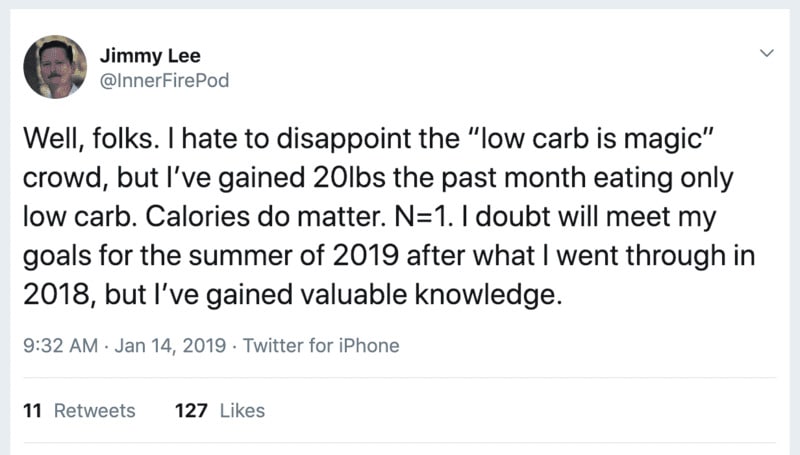
Think about it.
You’re looking for a magical weight loss plan on the internet. You heard that low carb was good. So you read up on it and realize you gotta ditch the carbs and increase your fat intake.
So you eat eggs, avocado, and a pound of bacon for breakfast. And then you add a ton of extra cream in your coffee, no sugar.
Then for lunch, you have a greasy hamburger atop some veggies. You skip the bun and drown it with melted cheddar cheese.
For dinner, you fry up some chicken thighs in coconut oil and then fry some veggies in butter.
Very few carbs for the day but a massive amount of fat — to the tune of 200 grams depending on the size of your meals. That’s 1800 calories from fat alone.
Anyway… here’s what you need to know about how to set a caloric deficit…
Understanding BMR, TDEE, NEAT
There are 3 variables to become aware of to fully understand how a caloric deficit is created.
Those are:
- BMR (basal metabolic rate)
- TDEE (total daily energy expenditure)
- NEAT (non-exercise activity thermogenesis)
Basal Metabolic Rate (BMR) is what you burn at rest. It’s what you’d burn every day, no matter what to keep your body functioning and alive. Think of it like this… if you were to stay in bed all day doing nothing, your body would still require a certain amount of energy needed for function.
We tend to equate our activities such as training, cardio, walking around as what burns calories. And while those activities do burn calories, our bodies are also burning calories just to stay alive. All of your organs require energy from food to function normally.
Your brain requires glucose for processing power. Your stomach requires calories to digest food, which it turns into useable energy for later. Your heart requires energy to keep beating. Your skin and bones require energy to repair themselves from everyday cell turnover (cell replication).
For ease of explanation, I input some numbers into this calculator to help illustrate how this works.
As you see below, you have the inputs for height, weight, and activity level (I chose sedentary for sake of the question above).
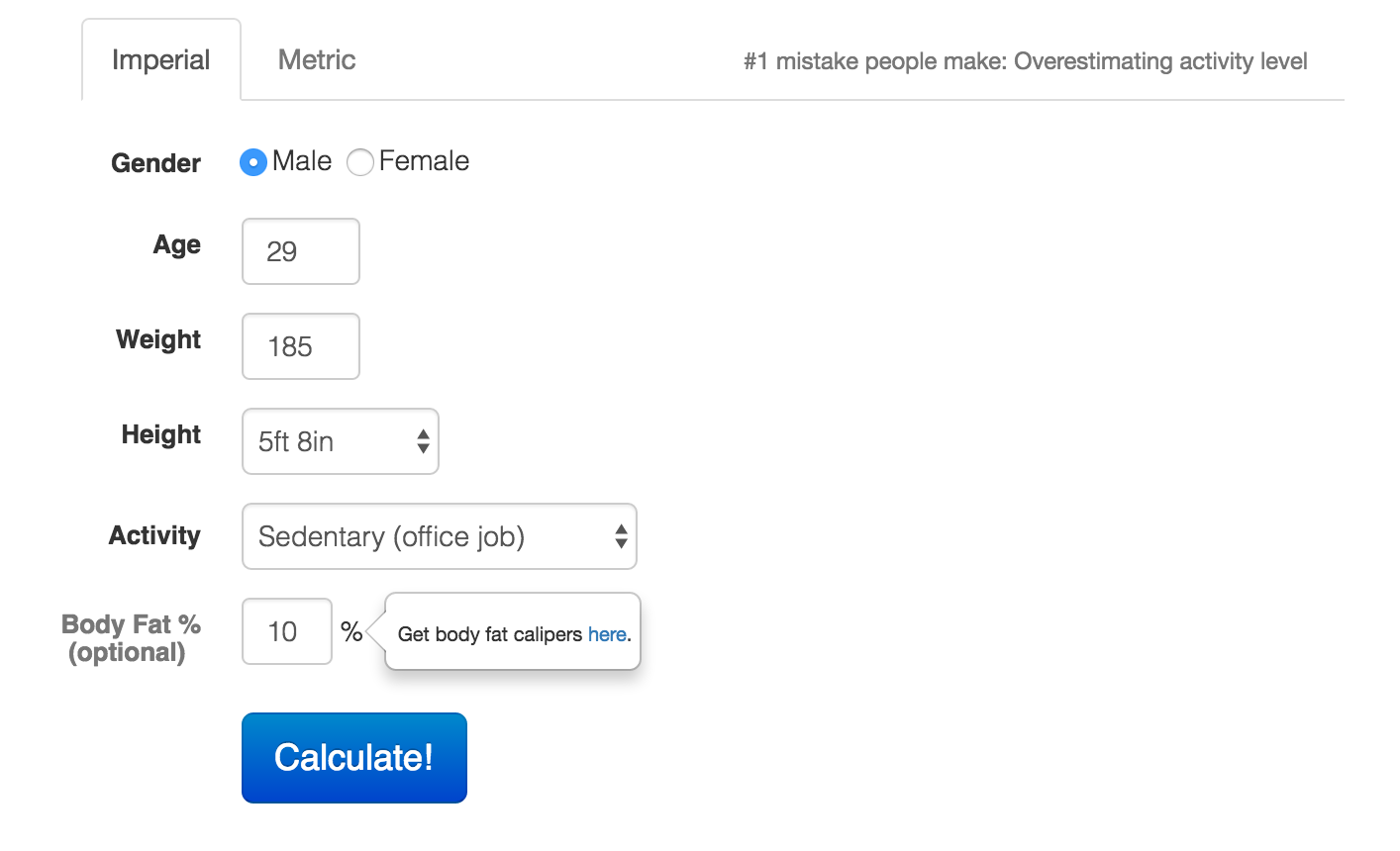
On the next page, here’s the calculation for the BMR.
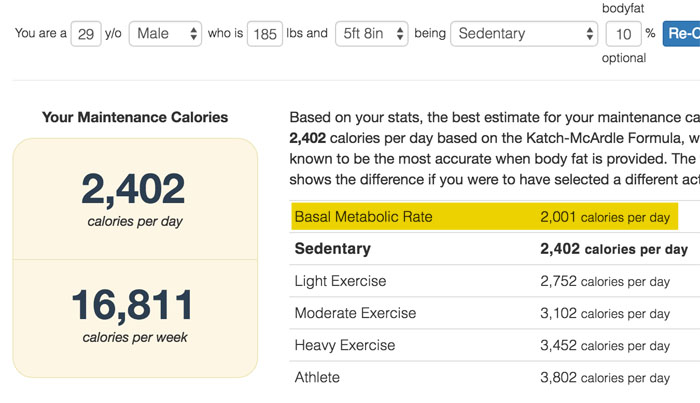
From here, you know that for a male at 185 pounds, he’ll be burning roughly 2000 calories per day just to survive. Our bodies are warm and as a result, they require a good amount of energy just to function on a daily basis.
Let’s next look at the activity on top of your BMR.
Total Daily Energy Expenditure (TDEE) is your BMR plus all the other energy expended outside of what it takes to keep your body functioning.
This includes moving around for daily tasks (getting out of bed, brushing your teeth, walking around your house, making food, going to work, training at the gym, playing frisbee in the park, etc).
All of that extra activity requires calories for energy. As a result, your total energy requirements go up. Let’s say that you’re training 3-4 days per week with weights.
As you’ll see by the example below, your daily requirements for calories (TDEE) goes up a good amount in relation to your BMR.
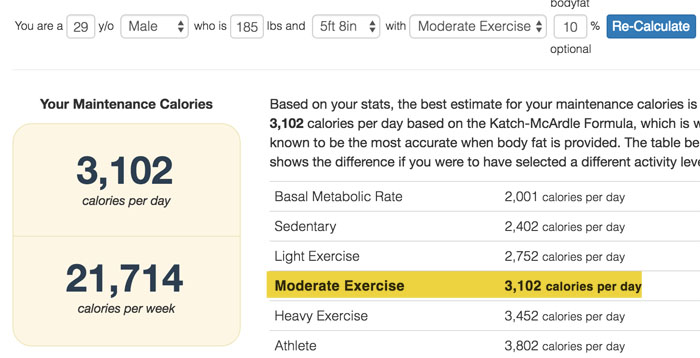
TDEE is also sometimes referred to as your maintenance intake, which is exactly what it sounds like: what it takes in terms of calorie intake to maintain your body weight, all activity included.
A common concern of many (myself included) is whether or not these activity calculators are 100% correct for every individual. The truth is they’re not. Sometimes your expenditure may not be in line exactly with the total amount of energy suggested to maintain your body weight.
So instead of taking these calculators as a defining measure of how much you need to eat on a daily basis, it’s better to see them as a starting point from which you can adjust over time based on real-world results.
If you eat according to the maintenance caloric level suggestions and you lose weight, you’ll need to eat more. If you gain weight based on the calculator’s recommendations, you’ll need to eat less.
So what gives in terms of the accuracy or inaccuracy of these calculators for everyone?
There are 2 variables:
- Tracking your nutrition accurately
- NEAT (non-exercise activity thermogenesis)
I’ve already covered how to track macros in the past. Give that article a read if you want to know all about that.
Non-Exercise Activity Thermogenesis (NEAT) is energy expended for everything we do that is not sleeping, eating or sports-like exercise. NEAT can differ widely from person to person. You might have 2 people who are seemingly identical in their daily habits, exercise intensity, muscular build, and eating habits but have differing levels of energy requirements.
Outside of some slight metabolic differences, the amount of food they need to maintain their weight will often be affected by their NEAT levels. Some people are generally more fidgety than others.
Some tap their foot during work, while others hardly move at all.
Some find it incredibly hard to sit still, and others can be perfectly fine vegging out on the couch all day. NEAT can have a drastic impact on your energy expenditure when it doesn’t outright negatively affect your daily routine.
For instance, the person who walks to work, or spends time getting up at regular intervals from their desk to stretch and move around are going to burn more calories from these activities than someone who drives to work and is chained to their desk.
This is why people with active jobs (people on their feet all day, those with delivery routes, doing manual labor) can seem to be bottomless pits when it comes to their food intake.
Use My Calorie Intake And Macro Calculator
Alright, to make things incredibly simple, I’ve created my own calorie and macronutrient calculator. What’s great about it is you simply enter your info and then it spits out a starting point for you to begin losing weight easily.
No guesswork. No doing a ton of math from the examples above.
Just plug in your numbers and get started.
Use the calculator:
Real-World Data Versus Hypotheticals
Now look — most all of the fat loss gurus online are going to give you guarantees.
They’ll say things such as
“if you follow this meal plan, you’ll lose 10 pounds next week.”
Or…
“This calculator is 100% accurate and backed by the enormous amount of research out of The University of Calorimetry.”
Note: there is no such thing as The University of Calorimetry. It’s a joke, in case you didn’t get it.
But I’ll let you in on a little secret.
All of this information is only a starting point. And that’s it.
My calculator is pretty damn accurate because I’ve used similar numbers with a multitude of clients to get them results. And it’s been cross-referenced with the science that is responsible for these BMR and energy expenditure calculations.
But just remember this…
You should keep records and be as accurate as possible when you’re charting your fat loss progress. Because there’s a chance that what the calculator spits out at you could be too much food.
Or it could be too little, where you lose weight quickly and your energy tanks.
So keeping track of what happens with your body weight over time, alongside tracking your macros and energy intake, is going to be the best method possible because it’s what’s happening in the real world.
It’s not hypothetical.
It’s not what could happen in an alternate universe.
It’s what’s actually happening in this simulation our alien overlords have built for us.
Case In Point: use the calculator to bypass all the math and frustration. Use it to establish a starting point for your fat loss calories and macros. But pay attention to what’s happening in the real world and make adjustments based on your experience.
Fat Loss Failures: Why You’re Doomed From The Start (+ How To Fix It)
Since you’re reading this article, I’m going to assume you’re familiar with the internet. And because you’re on the internet, I have a slight hunch you’ve seen lots of big promises about how to lose fat.
You’ve likely seen grandiose claims, such as these examples:
- “Lose 20 pounds of fat in 30 days eating whatever you want.”
- “Your hormones, not diet or exercise, is why you can’t lose weight.”
- “How to cure your sugar addiction, which is keeping you fat and unhappy.”
Now, look… those aren’t even the worst offenders. There are ads everywhere tugging at your emotions and self-worth. These ads are created to make you feel inadequate and that you’re doomed to fail if you don’t do what the ad is suggesting you do.
Remember this: that strange video you see on Facebook that suggests exercise doesn’t work, or that your diet of fruits and veggies (not kidding) is keeping you fat, is mostly wrong and they’re using mind tricks to make you feel like they have the only solution.
Here’s a recent example of a video someone posted in my private Facebook group.

I’ll let you in on a little secret.
Since you’re a human being, you’re susceptible to these messages promising a shortcut. We want everything to be easy and to happen instantaneously.
The Quick-Fix Mentality
But this is not your fault entirely.
You’re likely reading this article on your phone, tablet, or computer. And these very devices have changed our brains. They’ve trained us to expect everything to happen quickly.
You can Google the answer to almost anything you’d like to know and within a few seconds be looking at an endless stream of puppy videos on Instagram for hours.
You can order food, rent a movie, and even speak to a nurse about those embarrassing symptoms you’re having ALL FROM YOUR PHONE.
This is how we’ve primed ourselves to expect everything to happen quickly.
But guess what… losing weight, getting stronger, building muscle, reading a book, learning a language, getting better at dating, or learning how to fly fish all require a good amount of time and effort.
We always see the headlines promising a quick-fix to a hard problem. And for 99% of these claims, most of them won’t stand up in the real world.
Can you lose 20 pounds in a month? Technically, you can, but it won’t all be fat and you will likely suffer through the process. But that’s not the worst of it. Most people who diet and lose a lot of weight quickly end up gaining it back, and then some.
Can you build 10 pounds of muscle while gaining no fat in the process? For most people, no… muscle gain is an arduous process and it takes a lot of effort, smart training, and time. Those gaining 10 pounds of muscle in a few months are the people who’ve never trained in their life and are genetically on the skinny side (having naturally low levels of body fat).
Case In Point: Remember — all the sensationalized messages are designed to manipulate your emotions and ability to reason.
In this game, there are no quick fixes.
You didn’t gain 50 pounds of fat in a few weeks. It took months, likely years to put on the weight. As a rule of thumb, it’s likely going to take a similar amount of time to lose the weight in a manageable, sustainable way.
So now that you know what to look for and what to be aware of, let me clue you into some of the fat loss behaviors that will help you succeed in both the short and long term.
The Keystone Fat Loss Behaviors
You are a sum of your behaviors.
Not what you said you’d do.
Not what you wish you’d have done.
Not what plan to do.
You’re only as good as what you do.
In saying that, what you do regularly is what determines your outcomes.
It’s good to have goals, but it’s better to have a process. With all of my clients, we always focus on the process, not the outcome (goal).
We start with a goal in mind, but then we break it down to the process. The process is what it takes on a daily basis to move you closer and closer to the goal (fat loss).
The first step is to establish better habits.
You’re Only As Good As Your Habits
At the end of the day, you’re what you do, not what you said you’d do. I repeated this for a reason. Get it into your head.
Losing fat is a simple process, but it’s not always easy.
It requires a combination of the following:
- Regular exercise throughout the week
- Eating a diet that is healthy and also puts you into a caloric deficit
- Regular tracking and monitoring of progress
- Enough downtime for recovery and adequate sleep
But when you break this down even further, it gets more complex.
What type of exercise are you doing? How much exercise? Is your workout plan sustainable?
How are you going about following a healthy diet? How many meals are you having per day? What types of foods are you trying to eat enough of? Which foods are you trying to avoid?
What type of plan do you have for progress tracking? How will you know you’re on track to reach your goals?
Are you getting enough sleep? If not, what’s the plan to make sure you’re getting enough rest to recover from the exercise?
If you don’t have answers to the questions above, do not fret. I’ll cover everything below.
Now let’s talk about the mother of all progress:
Consistency
No matter what… you can have the perfect diet or the perfect workout program, but if you don’t do it consistently, it won’t matter one bit.
I’ll take the person who can exercise 3-4 days per week consistently for a year over the person who can do a complicated 6-day workout program perfectly for a month or so at a time.
The people who are in the best shape and physical health are those who’ve spent years in the practice of the primary principles.
In fact, if you talk to an expert in any field, they’ll always tell you that everything comes down to the fundamentals. If you’re not consistently working on and perfecting the fundamentals, no amount of time or effort spent on the advanced stuff will make a difference.
Now how do you make sure you create the consistency you need to succeed? You start with why it’s important to do whatever it is you’re doing.
Having a ‘WHY’
Most of the time, when we start out to accomplish a fat loss goal, we always have a reason for doing it.
You might want to have abs for your upcoming beach vacation.
Or maybe you want to wear your favorite pants without having your love handles spill over the sides.
Or maybe you just want to look better naked and be more confident with your body.
Regardless of what you’re trying to do, you must have a massive reason for why you’re doing it. Otherwise, you will fail.
In my book, Stay Leaner, Longer, I cover an exercise that helps you uncover the biggest, most ideal reasons WHY you want to get into better shape.
Because let’s face it. It’s very easy to say “I want to have six-pack abs” but when it comes down to the brass tacks, just wanting to change your body for vanity’s sake will likely fizzle after a short amount of time.
Here’s the exercise from Stay Leaner, Longer…
Sit down with a piece of paper and write down your goal at the top. Take a minute and think about what it is you want to accomplish. Let’s say you want to lose 30 pounds of fat and gain some muscle mass.
Now once you know your goal and have it written at the top, under the goal draw a line down the middle of the page.
On the left side, write the word ‘why?’ and on the right side, put the first statement that comes to mind.
It might look like this:
Why? | Because I want to not feel self-conscious when taking my shirt off on vacation.
And then you would ask yourself ‘why’ again.
Why do you want to not feel so self-conscious? You might write “because I want to be more confident with my appearance”
And then you’d write ‘why’ again and answer the question with “more confidence would help me in my relationships and my performance at work.”
And then you’d ask ‘why’ again and again until you get to a very strong reason for what you’re doing.
When you start the ‘why’ exercise, you’ll often get a shallow reason for wanting to get into shape and change your body. But after multiple times asking yourself why, you’ll tend to get a more substantial, bigger reason for why you’re setting these goals.
Because when it gets tough (and believe me, it will), it’s easier to stick to your goals when your reason for getting into shape is that you’ll have more energy and be in better health to perform your best at work and at home, than just wanting to have sick 6-pack abs for the beach.
Getting Accountability
When it comes to fat loss, it’s easy to say:
“I’ll start eating better and working out more starting on Monday”
But most people never get started.
And many look back over the previous month frustrated they never started that exercise or diet plan.
Then a year goes by and they realize it’s time to set a New Year’s Resolution to finally get into shape, once and for all.
Unfortunately, it hardly happens for most people.
And this is why having accountability can make or break your ability to succeed with your fat loss goals and efforts.
Getting expert fat loss coaching, or joining my Inner Circle is a great way to get the results you want, with expert guidance all along the way.
How To Lose Fat And Keep It Off (The Blueprint)
The following is everything you need to know in order to start losing fat and then keep it off for life. You need a combination of the following:
- A sustainable exercise program
- A diet plan you can follow easily that keeps you in a caloric deficit
- A plan to keep you on track
- The discipline to stick to the plan for enough time to see results
- Optional, but pretty important: support/accountability to keep you consistent
I’ll get into the specifics of training and diet in the upcoming sections. But for now, I want you to understand the following:
Without a plan to follow, you won’t know what to do on a regular basis.
And without the discipline to stick to the plan long enough, you won’t ever see results, even if you work out really hard for a few weeks consistently.
1. You Need A Roadmap And A Plan
Imagine being flown to a foreign city you’ve never been and told to navigate various landmarks without a guide or a phone with Google maps. And then imagine you couldn’t speak the language, so no chance in asking for directions.
It’d be near impossible to reach your destination. You’d likely never get there and if you did, it’d be from sheer luck. Chances are you’d fail massively.
The same goes with getting into shape, losing fat, and changing your body.
Nothing happens by chance. You need a plan that is both clear and actionable in order to reach your goals.
2. Discipline + Good Habits = Results
The road to hell is paved with good intentions. But just having good intentions and trying to eat better and exercise more is not what will help you succeed.
You need the discipline to work out and eat better, and then you have to do it consistently. Most people who start off in January do so with a lot of motivation and focus. They go to the gym frequently. They start strong with their diet.
They put themselves into a routine. But it doesn’t last.
Their initial efforts were amazing but they didn’t follow through. And it’s not because they’re dumb, or helpless, or stupid, or they didn’t have enough knowledge.
It’s because they weren’t consistent long enough to see the fruit of their labor.
3. Understand Where You Are And Where You Want To Go
The best way to get the results you want is to be 100% honest with yourself. Most people underestimate how much weight they need to lose, or how much exercise will be required to reach a goal.
Many times I find men who want to get lean enough to see six-pack abs and they think they just need to lose 5-10 pounds and it’ll take 1-2 months. But in reality, they need to lose 25 pounds and it’ll take 3-4 months, at least.
If you’re 50 pounds overweight, you must realize that it took months and years to become this overweight. And it’ll likely take a considerable amount of time to reverse it. It doesn’t have to take as long as it took to put on the weight, but it’s not going to come off easily in just a few months of working out whenever you want and eating a mostly clean diet that you rarely stick with.
It will take hard work, a regular exercise plan, and attention to detail with your diet. And most of all, it will take time and consistency.
Now that you know a bit about what this will take, let’s get into the exact steps of how you can lose fat practically and predictably.
The Lose Fat Workout Plan
Let’s get some of the not-so-obvious things out of the way first.
Despite what you may have heard…
- You don’t have to do any cardio to lose fat.
- You don’t have to go to the gym 6 days per week and work out for 2 hours at a time.
- You don’t need to do a lot of high reps with lighter weights to get leaner.
- You don’t need to constantly change up your fat loss workout plan to ‘keep the body guessing’ or any of that nonsense.
Here’s exactly what you need to know to lose fat effectively and efficiently.
Ideally, you will focus on doing the following incredibly well:
- You will use strength training as your main form of exercise 3-5 days per week.
- You will keep track of your workouts and aim to make progress by utilizing progressive overload principles.
- You will follow a program that allows you to gain strength, make progress, and improve over time.
Here are two good examples of solid fat loss training programs which come from my workout plans article.
Full Body Training 3 Days Per Week
Here’s a sample full body program:
Program A
Major Compound Movements
- Squats | 3×5
- Dumbbell Bench Press | 3×10
- Bent over Barbell Row | 3×10
Accessory Movements
- Lying Leg Curls | 4×15-20
- Dumbbell Side Lateral Raises | 4×8-10
- Face pulls | 4×12-15
On the next day you train, you could do the same routine and try to add weight, or reps to each set, or you could do a different routine with similar movements and setup.
Here’s an example of something you could do later in the week.
Program B
Major Compound Movements
- Romanian Deadlifts | 3×5
- Lat pulldown machine | 3×10
- Seated Dumbbell Presses | 3×10
Accessory Movements
- Leg Extensions | 4×15-20
- Machine Chest Press | 4×8-10
- Band Upright Rows | 4×12-15
The way to make this work is to pick two (or three) days per week to train, preferably non-consecutive days. You could train on Mondays and Thursdays, Tuesdays and Saturdays, Wednesdays and Fridays — I’m sure you get the point.
When training three days per week, most people do Monday, Wednesday, and Friday and take the weekend off.
Now here’s an example of another program that works incredibly well, too.
Upper/Lower Split Training 4 Days Per Week
With an upper/lower split, you’re typically training all muscle groups two times per week. There are four separate sessions: two for the upper body and two for the lower body.
There are limitless options when setting up this type of workout plan, but here’s the gist of it.
You’ll aim to hit all muscle groups evenly over the course of a week, dedicating specific exercises and sufficient volume for each group.
On lower body days, most will opt for one to two compound lifts followed up with some accessory or isolation movements.
The same goes for upper body. Most people will choose two to four compound movements for to cover their back and chest muscle groups and follow them up with accessories.
A quick example of a very simple upper/lower split will look like this:
Lower Program A
Major Compound Movements
- Squats | 4×8-12
- Glute-ham raise | 3×10-12
Accessory Movements
- Leg extensions | 3×12-15
- Dumbbell Romanian Deadlift | 3×8-10
- Seated calf raises | 4×12-15
–
Upper Program B
Major Compound Movements
- Incline Bench Press | 5×5
- Weighted Chin-up | 5×5
Accessory Movements
- Flat Dumbbell Bench Press | 4×8-10
- Seated Cable Rows | 4×8-10
- Seated DB Lateral Raises | 3×12-15
- Cable Face Pulls | 3×12-15
Most people will train two days in a row, take one day off, and then finish the week with two more training days.
For a more advanced version of this type of setup, ideally, you would train a form of the deadlift on your next lower day with a light squat movement coming afterward. On upper days, you could switch up the order of the exercises to hit the back muscle groups first instead of the chest/shoulders.
Let’s discuss the way to lose fat with a proper diet.
The ‘Lose Fat’ Diet Plan
Everyone wants a fat loss diet plan. Many are looking for meal plans with instructions on exactly what to eat. However, there are two factors that determine whether or not you lose weight with your fat loss diet plan.
Those are:
- You maintain a caloric deficit.
- You’re able to consistently stick to your diet.
Now, how you maintain a caloric deficit is entirely up to you. Some people will follow a more traditional dieting approach and eat 5-6 small meals per day. Others prefer to be on the other end of the spectrum and eat 2 meals a day while fasting for 16 hours.
Your individual preferences for meal frequency don’t matter all that much from a perspective of losing fat consistently. If you know you need to eat 2000 calories to maintain a caloric deficit, you can have two meals of 1,000 calories each or five meals of 400 calories each.
You could eat all your food before noon, or wait until 5 pm to eat all your food in one meal.
The math of fat loss is fairly simple. You eat less than you burn consistently and you lose weight.

Now individual preferences will determine what meal frequency and diet style you do better with. For instance, some do well with eating 3-4 regular meals. Others do well with intermittent fasting.
Quick note: Intermittent fasting is popular, but it’s not always the best for many people. In fact, it can cause issues with stress and anxiety, which makes dieting that much harder and less enjoyable.
See my video on this topic:
So what about the details? How much protein, carbs, and fat should you eat? What are the specifics of a good fat loss diet plan?
Let’s get into it.
What About Fat Loss Macros?
Alright, if you’re unfamiliar with macronutrients, see this article: what are macros?
Here’s the rub… for optimal fat loss to occur, there’s a hierarchy of what’s most important in terms of macronutrients.
The three macronutrients are:
- Protein
- Carbohydrate
- Fat
And you can say alcohol is the 4th macro, but it has no nutritional value. Alcohol is pretty bad for you and it’s terrible for fat loss. See my alcohol and weight loss article for more info.
So let’s look at it like this.
Protein Requirements
Protein helps preserve muscle mass when you’re on a diet. And when you lose weight, you want all of that weight to come from fat. The best way to lose fat is to ensure your protein intake is sufficient. And assuming you’re strength training, you will certainly maintain and maybe even gain muscle while losing fat.
As an online fitness coach, when I’m setting up diets for clients, I always focus on protein first. Then I worry about fat and carbs.
For protein, it’s a pretty easy formula. You simply take your body weight in pounds and that’s how much protein you should ideally aim for. In my article, how much protein do you need?, I cover all the science about why this number makes sense.
Now understand this one thing. If you’re very overweight, let’s say over 30% body fat and weigh over 200 pounds, you won’t need to eat this much protein. In fact, studies have shown that .8 multiplied by your body weight is sufficient for maintaining muscle mass.
So if you weigh 280 pounds and you’re at 40% body fat, 280 grams of protein is going to be pretty hard to reach on a daily basis. And the good news is you probably don’t need that much. In this example, you’d multiply .8×280, which equals 224 grams. And that’s a much easier number to reach than 280. In fact, you’d likely be okay at 200 grams.
But protein is not only about maintaining muscle mass, it also helps with hunger management. It helps you stay full and tends to be more satisfying than higher calorie, low protein foods.
Carbohydrate And Fat Requirements
These macros fall closely behind protein requirements, but they’re mostly seen as the ‘energy balance’ nutrients. There have been multiple studies showing that when a caloric deficit is present, the total ratios of carbs and fat doesn’t affect the weight loss results.
Basically, this means you could eat low carb or high carb, while still maintaining a caloric deficit, and you’d still lose weight. And most of that weight will be fat if you keep protein high and are weight training regularly.
My personal preference is to keep carbs and fat as high as possible while still seeing fat loss on a consistent basis.
You’ve probably seen lots of diets that call for 1200 calories to lose fat fast but in reality, they’re doing you a major disservice.
Not only will you be massively hungry, but you’ll also likely be losing muscle along with the fat because your body can only lose so much fat at a time. The bigger the deficit, the more risk you run of burning muscle tissue.
For the most part, I’m partial to a moderate protein, higher carb, and moderate/lower fat approach when setting up macronutrients. Now that doesn’t mean a lower carb, higher fat approach doesn’t work. It does… I’ve seen it over and over.
But this is my preference and here’s my reasoning:
- With more carbs, you get to eat more nutrient-dense fruit
- High-fat foods many people gravitate to aren’t typically high in nutrients (see bacon, fatty cuts of meat, oils, cream, etc)*
- Carbohydrates are great for keeping your energy levels high to sustain intense weight training.
*one note: I realize there are high-fat foods with a decent nutrient profile, such as nuts, avocados, fatty fish, etc. but I prefer higher carbs to allow for more fruit, veggies, and tubers.
To make this easy, I’ve created a simple calorie intake calculator. It starts by establishing your maintenance calories and then spits out a highly-accurate starting point based on your goal of fat loss or muscle gain.
As you use the calculator, you’ll see it spits out some starting macros for you based on your body weight and goal.
Now let’s discuss a factor MOST are overlooking.
The Most Important Fat Loss Macro (Sleep)
We sleep a third of our lives. Most people tend to neglect sleep because it’s not something we’re taught much about in school. In fact, we didn’t know a lot about sleep until fairly recently in history.
It’s just something we’ve naturally done for hundreds of thousands of years and it’s a highly refined process we can thank evolution for.
But how does it affect fat loss?
In short, when weighed across everything else like the specifics of nutrition and the type of training you’re doing, your ability to get sufficient sleep will massively impact your body composition.
And you can seemingly do everything perfectly — follow the perfect diet, follow the most perfect training program and still fail to see the results you want if you’re not sleeping enough.
A study done in 2010 makes this incredibly clear.
Straight from the study:
“During the two-week, 8.5-hours-in-bed phase, volunteers slept an average of 7 hours and 25 minutes each night. In the 5.5-hour phase, they slept 5 hours and 14 minutes, or more than two hours less. The number of calories they consumed, about 1,450 per day, was kept the same.
“The volunteers lost an average of 6.6 pounds during each 14-day session. During weeks with adequate sleep, they lost 3.1 pounds of fat and 3.3 pounds of fat-free body mass, mostly protein. During the short-sleep weeks, participants lost an average of 1.3 pounds of fat and 5.3 pounds of fat-free mass.”
Do you see that?
Those who slept for 5.5 hours per night lost mostly muscle while those who slept 8.5 hours lost equal parts muscle and fat.
Now here’s what these people weren’t doing:
- Eating a healthy, protein-rich diet
- Following a structured weight training routine
When you combine good nutrition and a solid strength training program with enough sleep and rest, you will be able to lose the majority of your excess body weight from fat and maintain most all of your muscle mass.
Sleep is the most important part of the fat loss process… yes, even more important than the diet or training because without proper rest and recovery (which happens when you sleep), you cannot reap all the benefits from proper training and nutrition.
To further your understanding of why sleep is so important, listen to this Joe Rogan podcast with Matthew Walker Ph.D., and then read Matthew’s book, Why We Sleep.
Sample Fat Loss Meal Plan
Okay, so look — nutrition is very important when it comes to fat loss, and you’re probably wondering what a typical day of eating might look like on a fat loss plan.
So here are some examples of what a fat loss meal plan might look like.
For men:
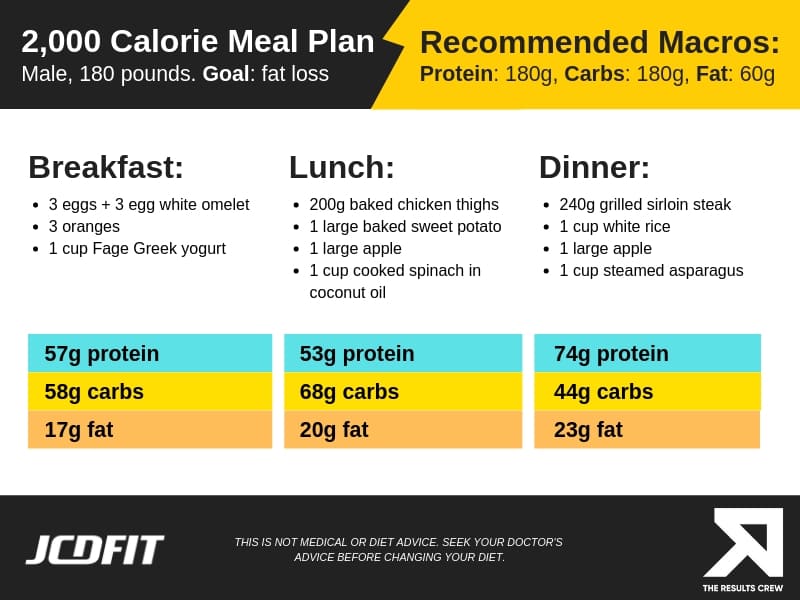
For Women:
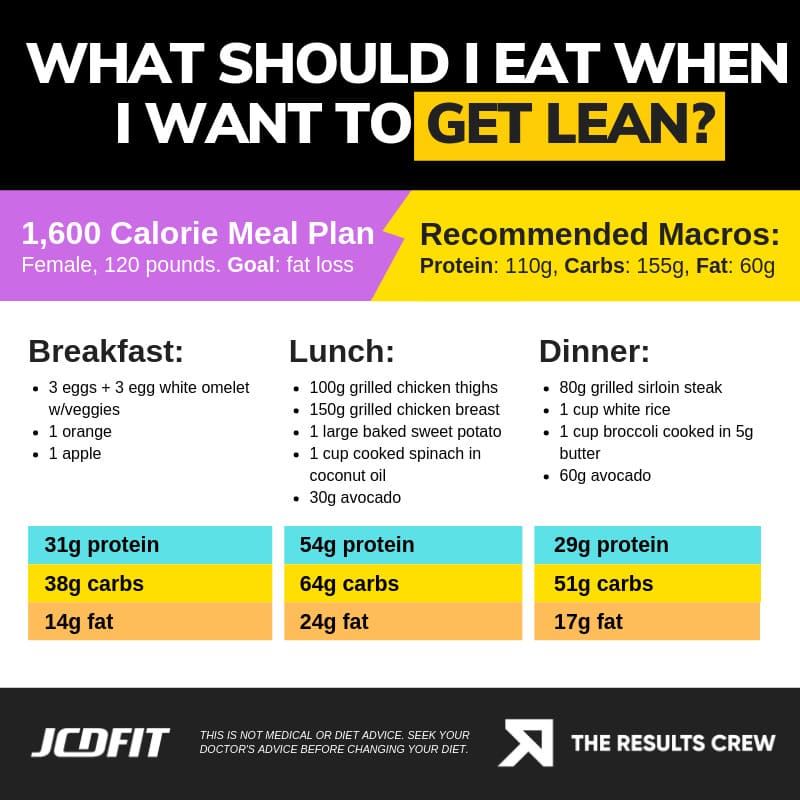
Now that you see some sample meal plans, you need to consider this one thing: familiarity is your friend.
The more routine and structured you can make your eating habits, the better off you’ll be.
I created a little framework called BBED, which stands for the Boring But Effective Diet.
You want your diet to be boring but effective, which means you eat similar foods on a regular basis. You know when you’re having your meals and what you’re having for each meal.
Here’s a quick video on this topic:
Ultimately, to make this work, you should follow these 4 principles:
- Maintain a caloric deficit for a fixed amount of days per week (4-6)
- Focus on hitting macronutrient goals for protein, fat, and carbohydrates
- Stick to a fixed meal schedule of uniform, predictable meals that work for you (3-4 meals per day is enough for most)
- Focus on nutrient-dense whole foods 85% of the time
We’ve already covered the caloric deficit needed for fat loss… and you should know by now how important protein and hitting your macronutrient numbers are. So here’s what I recommend for your meal schedule and focusing on eating whole foods.
A Fixed Meal Schedule Of Predictable Meals Is Ideal
Your diet must be so easy to follow that it requires hardly any mental effort.
This means having planned, predictable meals ready at set times during the day. Here’s the template I follow:
Breakfast: protein smoothie with various fresh fruits like apples, kiwis, melons, pears, etc.
Lunch: lean meat such as chicken, fish, or beef with potatoes, or rice and leftover cooked greens from the night before.
Dinner: repeat of lunch, usually prepared fresh. I’ll also make enough for lunch the following day.
Focus On Nutrient-Dense Whole Foods 85% Of The Time
This goes without saying, but your diet should emphasize whole foods a majority of the time. Junk food is fine once in a while—maybe once per week but it shouldn’t make up the majority of your eating.
Focus on the following and you’ll be on your way:
- Lean cuts of meat (beef, chicken, pork), fish and eggs
- Root vegetables: potatoes, squashes, onions, yuca, carrots, radishes, etc. (just google root vegetables for more ideas)
- Fat from animals and some plants (coconut, olive oil, various nuts)
- Green veggies, cooked well for digestibility. Spinach is my favorite.
- Dairy (if you can tolerate dairy well)
I would generally stay away from the following:
- Meats that aren’t grass-fed, or are fed grains
- All seed oils and any highly processed oils (vegetable oils are terrible for you)
- Fast food
- Junk food, in general
If your 3-4 meals per day are full of whole foods, you’ll have a better chance of getting enough vitamins and minerals to keep your body healthy and functioning while dropping body fat.
What About Fat Loss Supplements?
In short, stay far away from any supplement that claims to improve, speed up, or cause fat loss to happen.
You’re likely to have read that certain supplements are a must for fat loss, but this is only a marketing message meant to make you part ways with your hard-earned money.
You’ve seen the bottles of pills that use the words “slimming” or “toning” or “thermogenic” but have you ever looked at the ingredients?
If not, I’ll tell you now. Most are shit.
The active ingredients are things like plant extracts, caffeine, or even ketones, which has become enormously popular as of late.
But truth be told, most plant extracts don’t work as well as they claim.
Caffeine is incredibly affordable when you compare the cost of a cup of coffee to the expensive, cheaply-made diet pill (that contains caffeine as the main ingredient).
And ketones being sold as a weight loss aid haven’t even been tested in humans… only in rats, in very high amounts. And guess what… you’re not a rat.
So keep this in mind… fat loss supplements are a massive waste of money.
What If You Want To Lose Fat Fast?
Losing fat fast is possible, but you must take into account how fat loss works and what is also realistic for you as an individual.
After reading this far, you obviously know how fat loss works. But can you lose fat quickly, and get the diet over with?
The answer is complicated, so let’s dive in.
There is a way in which you can lose fat faster than most people, but it’s dependent on these variables:
- Your starting weight
- You starting body fat percentage
- Your levels of stress
- Nutrition and protein intake
Your Starting Weight
The heavier you are, the more weight (and fat) you can lose in the beginning. And the lighter you are, the less weight (and fat) you can lose. Here’s why.
When you are heavier, you naturally burn more calories than someone lighter. For instance, the man weighing 250 pounds is going to have a higher Total Daily Energy Expenditure (TDEE) than a man weighing 150 pounds.
For example, the man weighing 250 pounds who works out 3-4 days per week could burn up to 3500 calories (or more) per day while the 150-pound man working out a similar amount of time burns 2400 calories per day.
Automatically, the heavier man has more food to work with in terms of creating a caloric deficit.
For an extreme example, and this is not ideal, the man weighing 250 pounds could eat 2000 calories per day, which would be creating a 1500 calorie deficit… and if you do the math, 1500×7 = 10,500 calories, which could equate to 3-4 pounds of fat lost per week!
Now take the 150-pound man. If you were to subtract 1500 calories from his 2400 calorie maintenance levels, he’d be left with a paltry 900 calories, which is a starvation diet and sure to cause all kinds of problems.
But starting weight alone is not enough to determine how fast you can lose fat. We must talk about body fat percentage.
Starting Body Fat Percentage
Your starting body fat percentage is everything… If you are very lean, let’s say a man less than 10% body fat (for women, less than 20%), you have no business creating a massive caloric deficit for three reasons:
- You don’t have much fat to lose
- Your energy levels will decline (and so will your performance)
- You will most likely lose muscle mass if you create too big of a caloric deficit
However, if you’re starting with a higher level of body fat, let’s say 30% or higher for men, and 40% or higher for women, you can afford to create a bigger caloric deficit to lose fat.
Here are some photo guides for what body fat percentages look like:
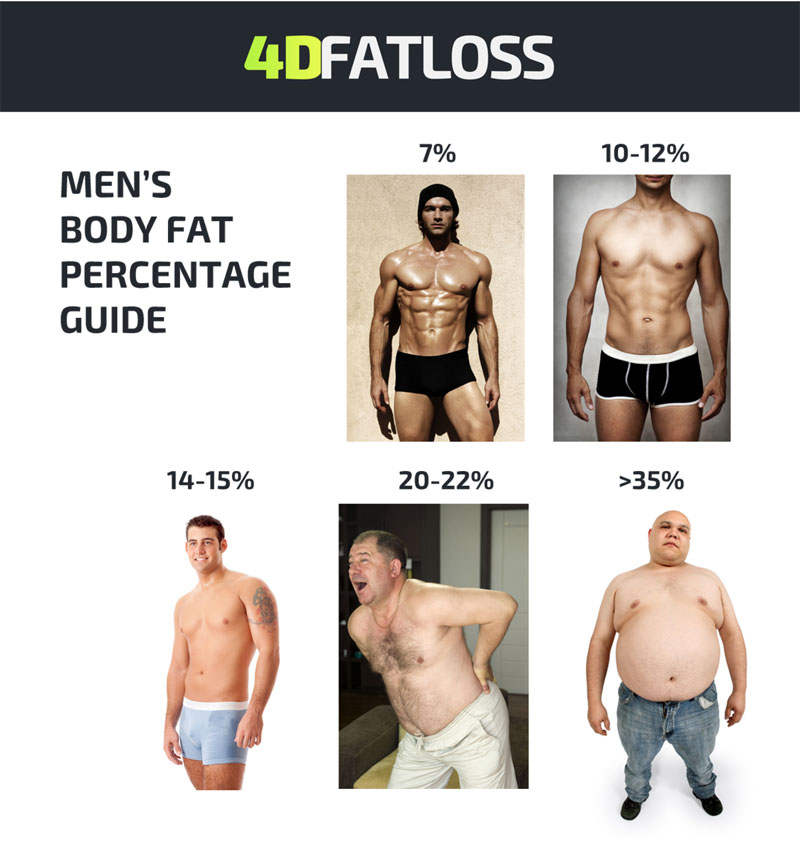
Body Fat Percentage Guide for Women:
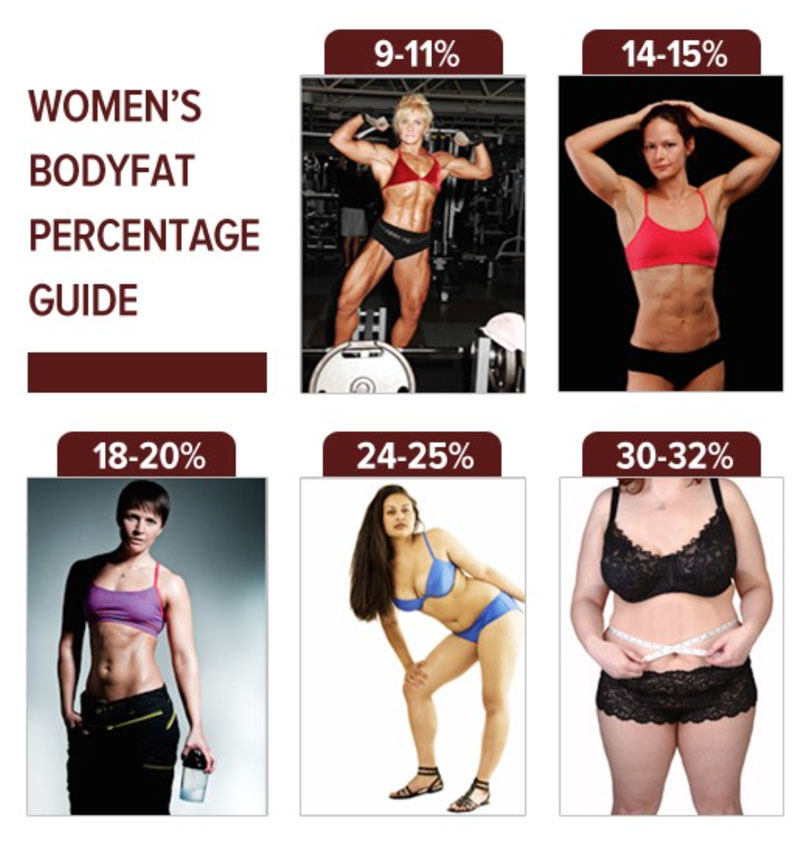
When it comes to setting the caloric deficit, I must make one thing clear… I don’t recommend losing fat super quickly unless you’re very overweight, then it makes sense.
In any case, I think a reduction in .5 – 1.5% of your body weight per week is ideal depending on your starting point.
So if you weigh 200 pounds, this means you could lose anywhere from 1-3 pounds per week. If you’re a man above 30% body fat (40% for women), you might want to focus on losing 2-3 pounds per week. If you’re under 15% body fat (25% for women), you’d want to focus on losing .5-1 pounds per week.
But remember this… the heavier you are and the more body fat you carry, the more weight you can lose quickly.
How Stress Levels Affect Fast Fat Loss
As we mentioned in the section on sleep, your lack of rest and ample sleep will severely retard your ability to lose fat when you’re on a diet.
High stress levels will also negatively impact your ability to make progress, as well. Most people underestimate how stressed they are and just assume that it’s normal to feel tired, lethargic, and anxious all of the time.
Add an intense weight training and exercise schedule, plus a caloric deficit to an already stressful lifestyle, and you are only pouring fuel on the fire.
A lot of people say you must ‘manage stress’ but without specifics, this really means nothing. Everyone has various levels of stress in their lives and it’s really something that you have to address on your own.
Going into all of the details about how stress negatively affects you is beyond the scope of this article, but here are a handful of ideas you can begin to think about regarding stress in your life:
- Are you lacking a balance of leisure/relaxation with your work schedule?
- Have regular sleep habits? (ie: you go to bed at a specific time and wake at a similar time while getting 7-9 hours of sleep per night?)
- Do you participate in activities that stimulate you and are enjoyable on a regular basis?
- Is there conflict at home or at work that affects you emotionally or psychologically?
There are many other factors, but here’s what you need to know…
Dieting, exercising, and especially weight training are all forms of stress you’re imposing on your body to produce a result, as known as fat loss. And if you’re already stressed, adding a caloric deficit, plus training is only going to increase stress.
So how does stress affect fat loss?
Stress directly affects your ability to recover from hard exercise. And if you don’t fully recover, you will not make the adaptations, or see the fat loss or muscle growth you want and deserve. It can also make it harder for you to lose fat indirectly because more stress typically means less quality sleep, and it causes stress hormones like adrenaline, cortisol, and norepinephrine to rise, which can be catabolic and break down muscle tissue.
It gets way more complicated but know this… the less stressed you are, in general, the more favorable your fat loss results will be. Just like the sleep study referenced above… if you’re not getting sufficient rest and balancing stress, the weight you lose won’t be in the form of purely fat, but muscle as well.
So what’s the remedy?
If you’re a normal person with varying levels of stress, don’t attempt fast fat loss. The more you exercise and restrict calories, the harder on your body it will be. And you’ll end up losing less fat, more muscle, and being miserable overall from all the added stress.
Nutrition and Protein Intake For Fat Fast Loss
There is only ONE way to make this work and you can’t mess this up. If you want to lose fat fast, you need to prioritize protein intake and just enough weight lifting to maintain muscle so you don’t lose unnecessary amounts of muscle.
In terms of protein intake, I recommend you eat about 1 gram per pound of body weight as per my how much protein do I need article, but when you’re trying to lose weight fast, protein intake becomes even more important. As a result, I recommend you take it as high as 1.5 grams per pound of body weight.
So if you’re 200 pounds and creating a 1,000 calorie per day deficit, you’d want to aim for 300 grams of protein (which is 1.5×200). Yes, that’s a lot of protein, but it’s essential when you’re in a steep deficit.
For the rest of your nutrition, you will need to work with the total calories you have. So, for instance, if you weigh 200 pounds and your maintenance intake is 2800 but you’re eating 1800 calories for fast fat loss, you’d need to keep in mind how many calories you have to work with.
1800 calories isn’t much at all. And with 300 grams of protein, you’re already at 1,200 calories (at 4 calories per gram of protein). That means you only have 600 calories left for fat and carbohydrates.
So in this case, I will tend to split the calories down the middle and have 300 for carbohydrates and 300 for fat.
The macro intake would be as follows:
- Protein: 300 grams
- Carbohydrate: 75 grams
- Fat: 33 grams
JC’s Expert Advice:
This is NOT an ideal macronutrient intake. In fact, it’s highly impractical and should never be used for more than a few weeks at a time. And if you’re using this type of approach, you should have a carbohydrate refeed once every week or so.
Fat Loss And Muscle Gain
Here’s the rub… losing fat while simultaneously building muscle is what they call a Fool’s Errand. Trying to chase two goals at once is going to leave you in a mediocre place with your body composition after 12 weeks, or however long you try to do two things at once.
That is unless you’re brand new to weight training, and haven’t been active your entire life. Then you might be able to lose fat and build muscle at the same time, but it doesn’t last longer than about 6 months or so until you start to notice a massive plateau.
The reason this happens is that the stimulus of strength training and exercise is so great in the beginning that it can drastically change your body composition by forcing the body to build muscle to adapt to the demands of the weight being lifted.
And most of the time, people go from a fairly poor diet, or a diet lacking in much protein, to one that is healthier, and containing more protein than before. So these changes alone are responsible for the initial body composition changes.
But… it doesn’t last forever. And that’s when you need to get specific.
The reason you can’t necessarily lose fat and gain muscle at the same time is that these goals are diametrically opposed.
For fat loss to occur you need what? You know this… c’mon now. A caloric deficit.
And for muscle gain to occur, you need a caloric surplus. In my bulking article, I go into all the details about how to gain muscle without getting overly fat.
However, there is a way to slowly gain muscle and lose fat, also known as a body recomposition plan. I cover that briefly in this image:
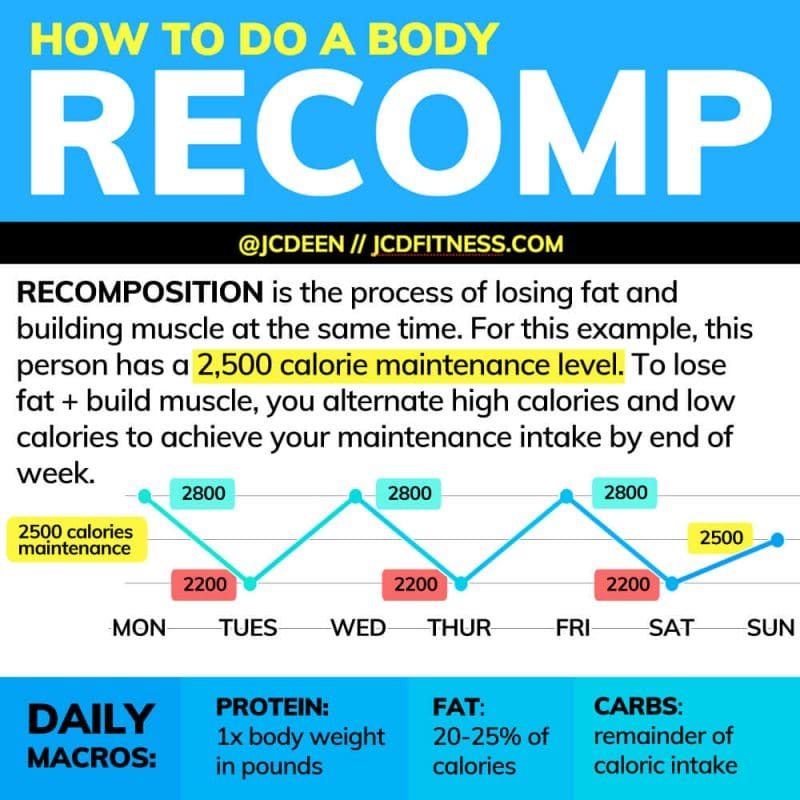
Just remember—attempting body recomposition by over eating some days and undereating on other days can be a very slow process. So be patient and track your progress if you attempt this approach.
Fat Loss Tips: Summing up
Here’s what we’ve covered, in short points:
- To lose fat, you need to create a caloric deficit.
- We want fat loss, not just weight loss. Fat loss = losing fat, not muscle. Weight loss = fat loss and muscle loss.
- A diet full of whole foods and lean protein sources is a foundation of a good fat loss diet.
- Excessive cardio doesn’t equal fat loss.
- Lots of exercise, in general, doesn’t equal fat loss.
- Weight training is the most ideal form of exercise to maintain muscle and lose fat.
- Low carb, low fat, Keto, Carnivore, Weight Watchers, and various other diet systems or eating plans don’t guarantee fat loss… a caloric deficit does.
- Fat loss doesn’t magically happen. You need a plan and you need to track your progress over time.
- No diet plan will help you lose fat unless it allows you to eat less than you burn on a consistent basis, over time.
- Sleep is the most important factor in whether you lose fat or muscle when you’re on a diet. Get more restful sleep.
- No supplements are worth the money for fat loss. Save your money, buy whole food instead.
- Fast fat loss is mostly a facade, don’t fall for this trap. Slow and steady wins the race.
Now, let’s get to the last thing we must address…
None Of This Matters Until You Do Something
You now have the tools, the knowledge, the know-how to lose fat and improve your body composition. But now you must put the actions into place that will make this a reality.
Here’s what I’d recommend:
If you’re ready to take the next step, you can check out my premium programs or apply for coaching, and get your best results yet.
